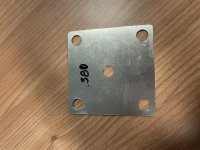I have a Tormach 440 (3/4 HP, 10,000 rpm spindle, 4" vise) and need a recommendation for an endmill to mill a hole in .125" 6061 plates.
2,3,4 flute? Carbide? flat or ball nose, Brands? I need a 1/16", 1/8" and 1/4" diameters.
Additionally, some advice on a fixture for the plates would be helpful. The plates arrive to me 3.0" x 3.0" with a milled hole (fixed size) in each corner and then my operation would be milling a single hole in the center. My initial idea is to simply mill a blank into a pair of soft jaws, or should i use top pressure so that the plate does not deflect?
Thank you!

2,3,4 flute? Carbide? flat or ball nose, Brands? I need a 1/16", 1/8" and 1/4" diameters.
Additionally, some advice on a fixture for the plates would be helpful. The plates arrive to me 3.0" x 3.0" with a milled hole (fixed size) in each corner and then my operation would be milling a single hole in the center. My initial idea is to simply mill a blank into a pair of soft jaws, or should i use top pressure so that the plate does not deflect?
Thank you!

Last edited:


